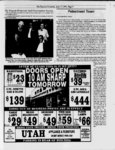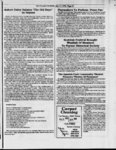| OCR Text |
Show The Payson Chronicle, July 17, 1991, Page 9 The Payson Historical And Preservation Society Historical and Preservation Society recently met to have a picture taken The Payson of its founding officers. A meeting for the public is planned for July 30. The Society is seeking new members. Please plan to attend. The Payson Historical Society: front row, left to right: Madoline Dixon Huseby (1st V. P.), Dale Wilson (Treasurer); back row, left to right, Beth Huish (2nd V. P.), Gloria Barnett (Pres.), Marie Stevenson (Sec.). Peteetneet Town by Madoline Dixon Huseby Jesse Knight, Pay sons first millionaire, was living on his ranch in west Payson when he "struck" it rich in the Tintic Mining District Almost immediately, his Humbug Mine began producing thousands of tons of rich silver and lead ore. As a result of his great wealth, he plunged into various industrial enterprises, among which was the construction of the Sugar Factory over the border in Canada. He had purchased a tract of land and made plans to establish a small community which he named Raymond in Alberta, Canada, in honor of his son Raymond. A number of Payson families were induced to move to Canada, namely the Seim an, the Fairbanks and Mendenhall families, to name a few. According to my book Peteetneet Town, Raymond Knight owned property on Depot Street in Payson at about the turn of the century. The street is now known as Utah Avenue. Rays two story adobe home stood on the east end of the block and was to be covered with white siding before it became known as the Payson Hotel. His big bam stood on the west end of the block and a long corral ran through the north end of the block. Ray kept his valuable race horses in one bam along with other livestock that he owned at the time. My book, Peteetneet II, adds more to the story. In the year of 1901, Ray Knight took train-load a of cattle and a few horses into Raymond, Alberta, Canada. The train consisted of ninety railroad cars. Tracks End was located at Cutbank, Montana, and the animals were taken from the cars at that point and trailed across the border into Canada. Ray s helpers were Eddie Dixon and several other Payson mere Eddie said afterward that Ray declared the horses were some of his favorite riding horses, not disclosing the fact that they were valuable thoroughbred race horses, thus saving himself the cost of duty paid to the government. After the animals were herded into bams and corrals in Raymond, the horses were later turned loose on the unfenced open range. Later, when the riders went out to round up the horses, they could not be found. The prairie was searched in a hunt that went on for many days, but the men UIiTi!! DAY3ED BADSTOOL could not find the hor- ses. There is more to the story, but I did not learn what it was until July 2nd of this year n when the Isaac Sel-ma- family held a EACH FRAMES 5 PC. DINETTE OAK Ct GLASS 2 PC. SOFA AND LOVESEAT ONLY SOLD IN PAIRS ONLY cams TABLE LALIPS sm BUSINESS ronraraa BRASS HEADBOARD BEDROOL1 n?i LPmtairr FLOOR TWIN SIZE SMTT3 $ VISA DISCOVER MASTERCHARGE O.A.C. 90 DAYS SAME AS CASH ONLY mm I am Values EACH PIECE SOLD IN SETS ONLY 20 From LALIPS EIATTRESS CHEST to K'W I ki l tl am u (O y HURRY MONDAY THRU SATURDAY 10 TO 6 373-276- 4 ) tH J 1 border by Ray Knight. He spoke of the horses that were lost on the prairie and said eventually they showed up in Payson, Utah. They had traveled all of those miles back to their home in Utah. And so the Canadians thereafter always told one another "Dont marry a Payson girl. They are apt to go back to their home in Payson, returned to their home in Payson many years HOURS: 255 WEST CENTER ST. PROVO, UTAH shipped across the just as the horses $130 APPLIANCE & FURNITURE reunion in Payson s Memorial Park. I was visiting with people from Raymond when I chanced to talk to Wesley Seiman who resides in that city in Canada. He happened to remember the story of the horses that were |























